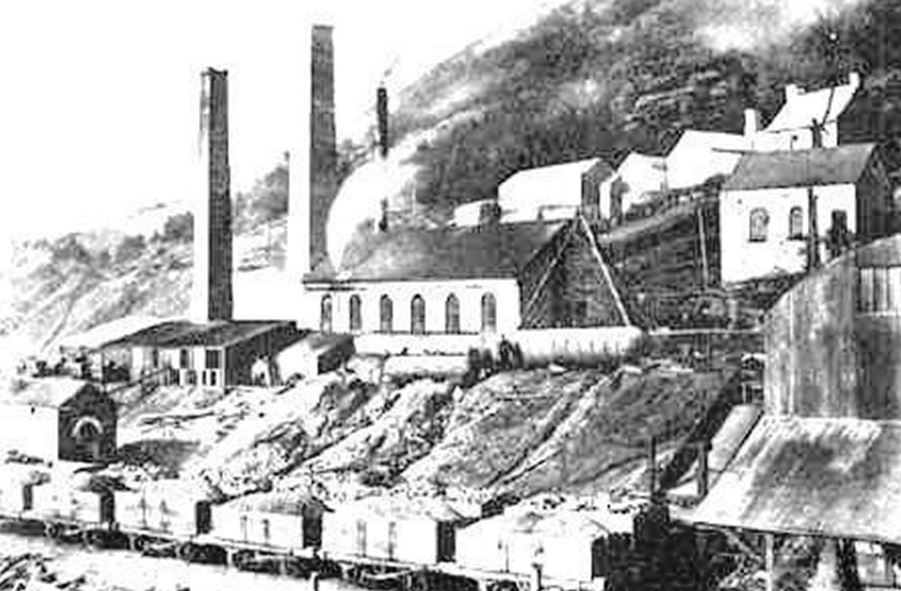Tynewydd, Ogmore Vale (93469054)
 The most southerly of the quartet of Cory Brother’s mines in this Valley. The others were Cwmfuwch, Penllwyngwent and Wyndham.
The most southerly of the quartet of Cory Brother’s mines in this Valley. The others were Cwmfuwch, Penllwyngwent and Wyndham.
The original drift was on the outcrop of the No.2 Rhondda seam and worked that seam, while the other drift (driven c1886) worked the No.3
Rhondda seam. Its mineral take stretched from Nantymoel in the north to Blackmill in the south. It worked the No.2 Rhondda seam at a thickness of between 33 inches to 42 inches, and the No.3 Rhondda seam extensively at a thickness of between 28 inches to 36 inches.
It was listed between 1865 and 1870 as being owned by Nicholson and Taylor and in 1883 as being owned by the Aber Coal Company with Edward Pugh the manager. In 1884 it was listed as being owned by the Aber and Ynisawdre Coal and Coke Company and managed by Lewis A Williams. Ownership had changed again by 1886 when it was owned by the Aber Colliery Company and managed by James Jones. In that year it worked the No.2 Rhondda seam by the pillar & stall method using safety lamps. Ventilation was by a 20 feet in diameter Waddle fan which was turned off on a Saturday afternoon and restarted at 9 pm on a Sunday. This was replaced by a 40 feet in diameter Waddle Fan in 1896.
By 1887 it was listed as working both the Nos.2 & 3 Rhondda seams. In 1894 the No.2 Rhondda slant was closed down and work was concentrated on the Rhondda No.3 seam slant. In 1896 it was owned by the Cory Brothers and managed by David Morgan, it employed 25 men underground and 17 men on the surface, in 1899 it employed 219 men and in 1900 it employed 321 men.
William Arthur Smith was a collier at Aber Collier, and coming off the night shift on the 10th of November 1906 placed 15 cartridges of gelignite in the oven and went to bed. About 11 a.m. the gelignite exploded and killed his wife, two children, and the lodger. He survived the explosion but was a nervous wreck. Following a trial Smith was discharged of guilt.
In 1908 it was managed by T. Redshaw and employed 146 men underground and 28 men at the surface. By 1909 it employed 174 men with Thomas Redshaw as the manager. Mr. Redshaw was still there in 1910/11 but the manpower had been cut to 47 and then 34.
In May 1913 after being on strike for five months the men sent a petition to the King asking him to intervene. The men wanted 1s 11d per ton of coal cut while the owners offered 1s 5d per ton. In 1913 it was shown to be employing 39 men with T. Redshaw still as manager. A.C. Evans was the manager in 1915 when it employed 40 men and D. Ferguson was manager in 1916/19 when there were still 40 men employed, this figure dropped to 20 in 1920 and further down to 10 in 1922/4. Mr. Ferguson was still the manager during this period.
In 1932 it was listed together with Cwmfuwch Colliery, but by 1935 only Cwmfuwch No.3 and Penllwyngwent were shown.
The Cory Brothers and Company was one of the last independent companies to resist takeover by one of the large combines such as the Powell Duffryn Steam Coal Company. It was formed as a limited company in 1891 and controlled twelve mines by 1913. It had offices in Cardiff, London, Glasgow, Liverpool, Paris and Genoa. It also had coal depots in 77 sites throughout the World.
On Monday the 14th May 1888 an explosion at this mine killed five miners; they were, Rees Joseph aged 62 years, Evan Jones aged 18 years, Jenkin Stanford aged 27 years, David Williams aged 30 years and Edward Gibbons aged 24 years. The fan ventilating the mine was normally stopped on a Saturday and not re-started until Sunday night. The only two other men in the mine at the time escaped unhurt. Following the inquest, the manager and under-manager were charged with manslaughter but the magistrates dismissed the case.
Information supplied by Ray Lawrence and used here with his permission.
Return to previous page
